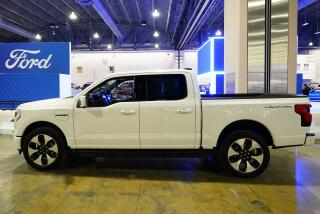Fiat vs. Fiat: Electric 500e and 500 Turbo comparison test
- Share via
The new Fiat 500e – an electric version of the bubbly Italian hatchback – compares well with battery-powered peers such as the Nissan Leaf or Honda Fit EV, as we noted in a recent comparison test.
But most buyers will care more about how the 500e compares to conventional gas-powered cars. So we lined up a Fiat 500 Turbo test car, the closest fossil-fueled match to the 500e and a strong entry in the fierce small-car segment.
Our 500 Turbo test car came with an as-tested price of $24,300. The electric 500 we tested recently penciled out almost exactly the same, at $24,545, once $10,000 in state and federal subsidies are subtracted. Their powertrains couldn’t be more different, yet they offer similar performance: 111 horsepower and 147 pound-feet of torque for the electric, compared with 135 and 150, respectively, for the Turbo.
With no distinguishing striping, scoops or wings, the two models look nearly identical – which is to say, weird, in a distinctly Italian way. A Fiat executive once compared the round body to the Michelin Man. The stubby front end barely qualifies as a hood. You can fit two of these buggers back to back in a compact-car parking space.
The transmissions provide the clearest contrast: A traditional five-speed manual in the Turbo versus a one-speed push-button in the electric. It seems odd to call the one-speed a transmission at all, given that it never shifts. But it works just fine in this application.
It’s easier to tell them apart on the highway with your ears than your eyes. The Turbo has an aggressive growl; the electric is a silent stealth fighter.
Here’s how they stacked up:
Efficiency: Not a fair fight. The Turbo gets decent mileage with an EPA rating of 28 mpg in the city and 34 on the highway. But electricity is really cheap compared with gas. In California, electric car drivers pay the equivalent of $1.51 per gallon. The national average is $1.14, according to recent figures from the U.S. Department of Energy. Advantage: 500 electric.
Practicality: Also not a fair fight. Don’t buy the 500e – or any electric car – unless your driving needs can accommodate a range of about 80 miles on a charge and a recharging time of about four hours. The 500 Turbo gives you the freedom to drive anywhere, any time without having to plan. Advantage: 500 Turbo.
Performance: In a stoplight drag race, the electric would dart out in front of the Turbo, thanks to the battery-powered model’s wellspring of instantly available torque. But the Turbo would catch and pass the 500e before the cars hit 60 mph. The Turbo clocks in at 8.2 seconds, according to Car and Driver. The electric takes 9.1 seconds, Chrysler says.
That makes it tempting to give the edge here to the Turbo. But most people’s driving habits, especially in traffic-choked Los Angeles, make off-the-line response more important than highway passing power. So let’s call this one a tie.
Cost to own: The electric 500 cost Fiat far more money to build than the Turbo, but it won’t cost you any more to drive. In fact, less. The price is about the same in a purchase, but almost all buyers will lease the electric version. That’s because Fiat is offering a $199-a-month, 36-month deal, with no down payment, to get consumers to ignore the drawbacks of electric cars. (Short driving range, uncertain resale and maintenance, and – until the recent electric-car price war – high relative cost.)
The Turbo model is going to run a good bit more on a lease. The base Turbo, with fewer options than our test car, leases for $279 a month for a longer term of 42 months and a $999 down payment. Advantage: 500 electric.
Fun factor: Tough one. Both these cars are a blast to drive. That’s about all they are; a toddler would find the back seat cramped. But as an urban runabout, the 500 – gas or electric – beats most compact cars. Both versions grip curves with a confidence that belies the impossibly short wheelbase. If you put earplugs in, it would be hard to tell these cars apart from the driver’s seat.
But it’s the noise, along with the transmission, that gives the slight edge here to the Turbo model. The silence of the electric motor, while welcome at times (like in stalled traffic) can’t replace the aural feedback of an internal combustion soundtrack. In spirited driving, nothing replaces the control of an old-school five-speed, even with the vague and oddly bulbous shifter in the Turbo. Advantage: Turbo.
Verdict: From the standpoint of pure driving enjoyment, buy the Turbo. Why mess with short range and charging times if the gas-powered model is more fun to drive anyway? But for certain drivers, the electric just makes too much sense. So buy the 500e if you have a short commute, this is your second car and you care about saving money.
RELATED:
Electric cars getting as cheap as gasoline rivals
Fiat 500 lease deal charges up competition for electric cars
Is Fiat moving to the U.S.? CEO hints at why it makes sense
@LAThevenot on Twitter







